
OBJECTIVES
At the end of this module you will be able to perform the following tasks in Pilipino:
- Ask for the departure or arrival time of a bus, plane, or boat and understand the answer.
- Ask about one-way or round-trip fares.
- Understand Tagalized Spanish terms for prices (20-60).
Audio for this lesson
Sa Takilya
At the Ticket Window
| Bob: | Kailan aalis ang bus para sa Maynila? | When will the bus leave for Manila? |
| Takilyero: | Aalis sa alas siyete impunto ng umaga. | It will leave at exactly 7:00 in the morning. |
| Bob: | Magkano po ba ang pasaheng balikan? | How much is a round-trip fare? |
| Takilyero: | Disisiyete pesos. | Seventeen pesos. |
| Bob: | Dalawang tiket na balikan nga po. | Two round-trip tickets, please. |
| Takilyero: | Heto po: trentay kuwatro pesos. | Here you are, sir: thirty-four pesos. |
| Bob: | Anong oras ang dating? | What time is the arrival? |
| Takilyero: | Darating sa alas nuwebe y medya. | It will arrive at 9:30. |
| Bob: | Maraming salamat. | Thank you very much. |
| Takilyero: | 0, sige po! | Happy trip! |
NOTES ON THE CONVERSATION
Aalis means “will leave/will depart.”
(Ang marks the topic of a sentence, so ang alis means “the departure.”)
Sa marks the directional focus. It may be translated as “in,” “at,” “to,” or “from” and may be preceded by a more specific preposition; e.g., para sa maynila, “for Manila,” mula sa Maynila, “from Manila.” Notice that sa is also used for time: “at seven o’clock” sa alas siyete.
Balikan means “round trip.”
Nga is equivalent to “please”; nga po is the polite form.
Anong is ano (“what”) with the linker -ng.
Dating is “arrival.” (Ang dating, “the arrival”; darating, “will arrive.”)
Maraming is marami (“plenty”) with the linker -ng.
- Tagalized Spanish numbers are generally used for prices and for telling time.
EXERCISES
Exercise 1. Repetition
| minibus | minibus | awto | automobile |
| bus | bus | doboldeker | double-deck bus |
| bangka | boat | erkonbus | air-conditioned bus |
| bapor | ship | dyip | jeepney |
| lantsa | launch, motor boat | trak | truck |
| eroplano | airplane | tren | train |
| kotse | car | taksi | taxi |
Exercise 2. Repetition
Kailan aalis ang minibus para sa Bulacan?
When will the minibus leave for Bulacan?
Kailan aalis ang tren para sa Baguio?
When will the train leave for Baguio?
Kailan aalis ang kotse para sa Maynila?
When will the car leave for Manila?
Kailan aalis ang lantsa para sa Corregidor?
When will the launch leave for Corregidor?
Kailan aalis ang eroplano para sa Cebu?
When will the airplane leave for Cebu?
Kailan aalis ang bapor para sa Mindanaw?
When will the ship leave for Mindanao?
Exercise 3.
| You hear: | bus – Maynila | |||||
| Say: | Kailan aalis ang bus para sa Maynila? | |||||
|
||||||
Exercise 4. Repetition
Kailan darating ang bus mula sa Subic Bay?
When will the bus arrive from Subic Bay?
Kailan darating ang bapor mula sa Leyte?
When will the ship arrive from Leyte?
Kailan darating ang lantsa mula sa Cebu?
When will the launch arrive from Cebu?
Kailan darating ang dyip mula sa Olongapo?
When will the jeepney arrive from Olongapo?
Kailan darating ang trak mula sa Bulacan?
When will the truck arrive from Bulacan?
Kailan darating ang minibus mula sa Nayong Pilipino?
When will the minibus arrive from Nayong Pilipino?
Exercise 5.
| You hear: | bus – Subic Bay | ||||||||||||
| Say: | Anong oras darating ang bus mula sa Subic Bay? | ||||||||||||
|
|||||||||||||
| Darating – “will arrive” (ang) dating – (the) arrival Aalis – “will depart, leave” (ang) alis – (the) departure |
Exercise 6. Repetition
Anong oras ang dating?
What is the arrival time?
Anong oras ang alis?
What time is the departure?
Anong oras ang dating ng bus sa Manila Cathedral?
What time is the arrival of the bus at the Manila Cathedral?
Kailan ang alis ng lantsa para sa Corregidor?
When is the departure of the launch for Corregidor?
Kailan aalis ang bapor para sa Iloilo?
When will the ship leave for Iloilo?
Kailan darating ang bapor mula sa Maynila?
When will the ship arrive from Manila?
Anong oras aalis ang dyip para sa Bulacan?
What time will the jeepney leave for Bulacan?
Anong oras darating ang tren mula sa Tarlac?
What time will the train arrive from Tarlac?
Anong oras ang dating ng kotse mula sa Manila Hotel?
What time is the arrival of the car from the Manila Hotel?
Anong oras ang alis ng eroplano mula sa Maynila?
What time is the departure of the airplane from Manila?
Exercise 7. Say in English:
- Kailan darating ang taksi mula sa Manila Hotel?
- Kailan aalis ang bapor para sa Palawan?
- Anong oras ang alis ng dyip para sa Bulacan?
- Anong oras ang dating ng awto para sa Laguna?
- Kailan ang dating ng bus mula sa Rizal Park?
Exercise 8. Say in Pilipino:
- What time is the arrival of the train at Baguio?
- When will the ship leave for Mindanao?
- What time is the arrival of the bus at Quezon School?
- When will the minibus arrive at Manila?
- When will the launch leave for Palawan?
- When will the jeepney arrive from Bulacan?
Exercise 9. Repetition
| beynte | 20 | kuwarentay uno | 41 |
| beynte uno | 21 | kuwarentay dos | 42 |
| beynte dos | 22 | kuwarentay siyete | 47 |
| beynte tres | 23 | singkuwenta | 50 |
| beynte otso | 28 | singkuwentay uno | 51 |
| treynta | 30 | singkuwentay dos | 52 |
| treyntay uno | 31 | singkuwentay nuwebe | 59 |
| treyntay dos | 32 | sisenta | 60 |
| treyntay singko | 35 | sisentay uno | 61 |
| kuwarenta | 40 | sisentay dos | 62 |
Exercise 10. Repetition
| Anong oras na? : | Ala una. Alas dos (tres, kuwatro, etc.). |
|
1. Alas tres. |
2. Alas sais. |
3. Ala una.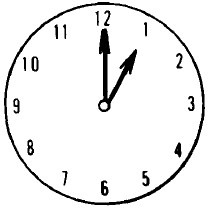 |
4. Alas dose.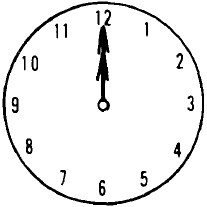 |
5. Alas singko.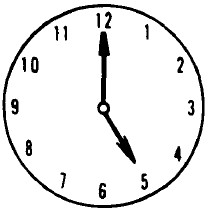 |
6. Alas kuwatro.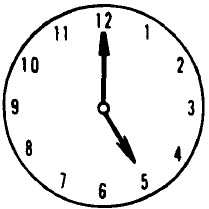 |
Exercise 11. Repetition
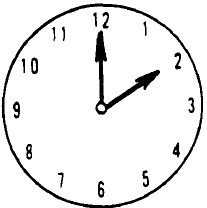 Alas dos impunto. |
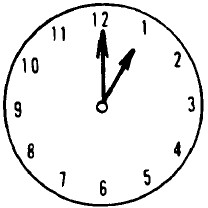 Ala una impunto. |
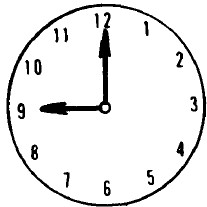 Alas nuwebe impunto. |
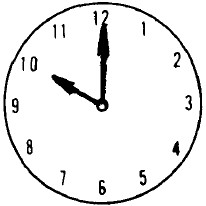 Alas diyes impunto. Alas diyes impunto. |
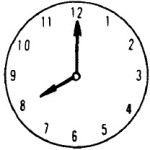 Alas otso impunto. Alas otso impunto. |
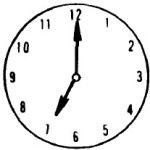 Alas siyete impunto. Alas siyete impunto. |
 Alas onse impunto. Alas onse impunto. |
Exercise 12. Repetition
| Anong oras na? : | Ala una singko. Singko minuto pasado ala una. |
 1. Ala una beynte-singko. 1. Ala una beynte-singko.OR Beynte singko minuto pasado ala una. |
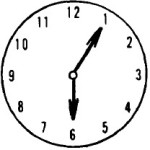 2. Alas sais singko. 2. Alas sais singko.OR Singko minuto pasado alas sais. |
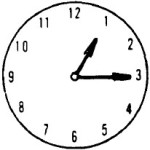 3. Ala una kinse. 3. Ala una kinse.OR Kinse minuto pasaso ala una. |
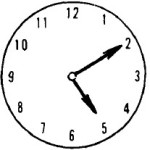 4. Alas singko diyes. 4. Alas singko diyes.OR Diyes minuto pasado alas singko. |
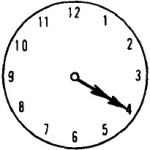 5. Alas kuwatro beynte 5. Alas kuwatro beynteOR Beynte minuto pasado alas kuwatro. |
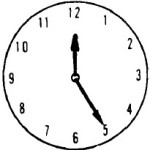 6. Alas dose beynte singko. 6. Alas dose beynte singko.OR Beynte singko minuto pasado alas dose. |
Exercise 13. Repetition
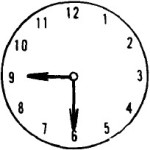 Alas nuwebe y medya. Alas nuwebe y medya. |
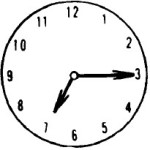 Alas siyete y kuwatro. Alas siyete y kuwatro. |
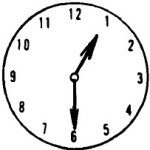 Ala una treynta. Ala una treynta. |
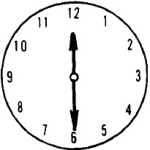 Alas dose y medya. Alas dose y medya. |
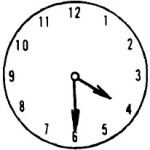 Alas kuwatro y medya. Alas kuwatro y medya. |
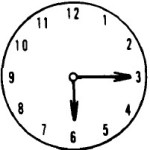 Alas sais kinse. Alas sais kinse. |
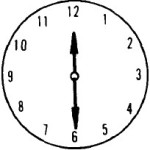 Alas dose treynta. Alas dose treynta. |
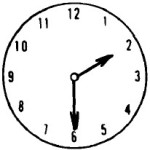 Alas dos y medya. Alas dos y medya. |
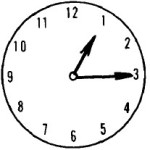 Ala una y kuwarto. Ala una y kuwarto. |
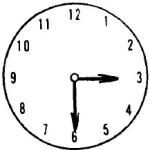 Alas tres y medya Alas tres y medya |
Exercise 14. Say in Tagalized Spanish:
|
1.
|
2.
|
3.
|
4.
|
5. |
6. |
7. |
8. |
Exercise 15.
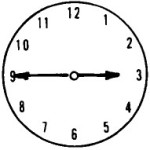 Menos kuwarto para alas tres. Menos kuwarto para alas tres. |
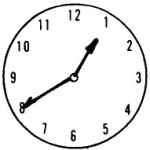 Menos beynte para ala una. Menos beynte para ala una. |
 Menos diyes para alas kuwatro. Menos diyes para alas kuwatro. |
 Menos singko para ala una. Menos singko para ala una. |
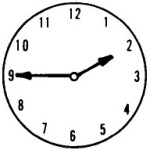 Menos kuwarto para alas dos. Menos kuwarto para alas dos. |
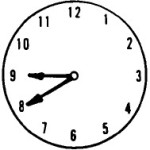 Menos beynte para alas nuwebe. Menos beynte para alas nuwebe. |
Exercise 16. Say in English:
- Alas tres.
- Alas siyete diyes.
- Menos kuwarto para alas nuwebe.
- Ala una y medya.
- Alas onse s ingko.
- Menos beynte para alas dose.
- Ala una impunto.
- Alas kuwatro y medya.
- Alas sais kinse.
- Alas diyes beynte singko.
Exercise 17. Say in Tagalized Spanish:
1.  |
2.  |
3.  |
4.  |
5.  |
6.  |
Exercise 18. Repetition
Anong oras aalis ang tren para sa Tayabas?
What time will the train leave for Tayabas?
Aalis ang tren sa alas kuwatro y medya.
The train will leave at 4:30.
Kailan aalis ang tren para sa Tutuban Station?
When will the train leave for Tutuban Station?
Aalis ang tren sa alas singko y kuwarto.
The train will leave at 5:15.
Anong oras darating ang eroplano mula sa America?
What time will the airplane arrive from America?
Darating ang eroplano sa alas siyete beynte.
The plane will arrive at 7:20.
Kailan darating ang eroplano mula sa Cebu?
When will the airplane arrive from Cebu?
Darating ang eroplano sa alas nuwebe kinse.
The plane will arrive at 9:15.
Exercise 19. Say in English:
- Aalis ang tren sa alas kuwatro y medya.
- Aalis ang bus sa ala una impunto.
- Aalis ang eroplano sa menos kuwarto para alas dose.
- Aalis ang tren sa alas siyete beynte.
- Aalis ang bus sa alas diyes.
- Darating ang bus sa diyes minuto pasado ala una.
- Darating ang eroplano alas onse y medya.
- Darating ang tren sa alas dose impunto.
- Darating ang bus sa menos kuwarto para alas nuwebe.
- Darating ang eroplano sa beynte minuto pasado alas tres.
Exercise 20.
| You hear: | Bulacan |
| Say: | Isang tiket na balikan nga para sa Bulacan. |
Exercise 21.
| You hear: | Baguio |
| Say: | Magkano ang isang tiket na deretso sa Baguio? |
Exercise 22.
| You hear: | Admiral Hotel |
| Say: | Magkano ang pasahe sa Admiral Hotel? |
Exercise 23. write the numbers you hear.
|
|
Exercise 24. Repetition
| dalawampu | 20 | tatlumpu’t isa | 31 |
| dalawampu’t isa | 21 | tatlumpu’t dalawa | 32 |
| dalawampu’t dalawa | 22 | tatlumpu’t siyam | 39 |
| dalawampu’t tatlo | 23 | apatnapu | 40 |
| tatlumpu | 30 |
| Pilipino | Tagalized-Spanish | |
|---|---|---|
| (one peso) | piso OR isang piso | (same as Pilipino) |
| (two pesos) | dalawang piso | dos pesos |
| (five pesos) | limang piso | singko pesos |
| (one centavo) | isang sentimo | (same as Pilipino) |
| (two centavos) | dalawang sentimo(s) | dos sentimos |
| (five centavos) | limang sentimo(s) | singko sentimos |
| NOTE: With Pilipino numbers expressing two or more, -s is optionally added to sentimo but never to piso. |
Exercise 25. Repetition
| tatlumpung piso | ₱30.00 |
| tatlumpung piso at pitong sentimo(s) | ₱30.07 |
| dalawampung piso at tatlumpung sentimo(s) | ₱20.30 |
| animnapu’t limang piso at limampung sentimo(s) | ₱65.50 |
| apatnapung piso at animnapung sentimo(s) | ₱40.60 |
Exercise 26. Write the prices you hear.
|
Exercise 27. Say in Pilipino:
- Three tickets, please.
- Five tickets, please, for Baclaran.
- What time is the arrival?
- How much is the fare for Olongapo?
- Many thanks.
Exercise 28. Repetition
| ENTRANCE | |
| EXIT | |
| WAITING ROOM | |
| RESERVATION | |
| INFORMATION | |
| WOMEN | |
| MEN | |
| BAGGAGE ROOM | |
| BAGGAGE | |
| OFFICE | |
| PARKING |
Exercise 29.
| You hear: | restroom | ||||||
| Say: | Pupunta ako sa C.R. | ||||||
|
|||||||
Exercise 30. Conversation for Listening Comprehension
| Dave: | Pupunta ba ito sa White Rock Beach? |
| Driver: | Hindi. Magdyip ka sa may Victory Station. |
| Dave: | Pupunta ba ito sa Victory Station? |
| Driver: | 00. |
| Dave: | Magkano? |
| Driver: | Espesyal? |
| Dave: | Hindi. |
| Driver: | Piso |
| Dave: | Malayo ba ang White Rock? |
| Driver: | Mga beynte minuto mula sa Victory Station. |
| NOTES: Sa may – near, by Espesyal – special. If you ride “special,” the jeepney becomes a taxi taking you directly to your destination without picking up passengers. It can cost significantly more than the normal fare; i.e., a 65 centavos’ ride can be as much as 10-15 pesos. |
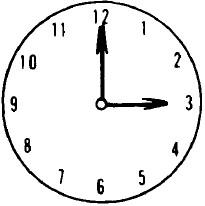
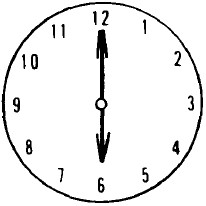




Leave a Reply